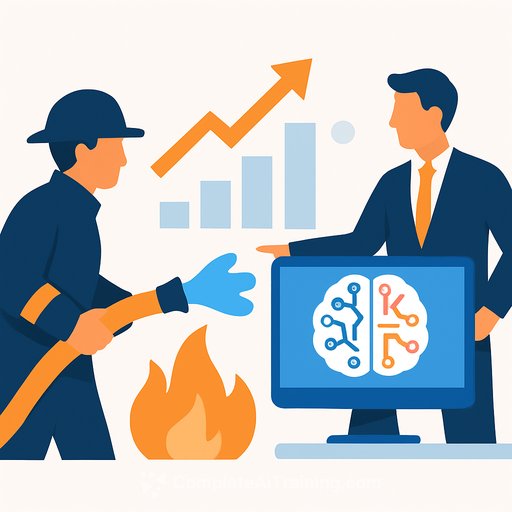Take Back Control: Why Smarter UC Management Is the Key to AI Success
Hybrid work, cloud-first strategies, and AI pilots have stretched Unified Communications to the limit. Many IT leaders feel stuck in reactive mode-costs up, service quality down, and little confidence in their data. This is fixable with a sharper approach to UC management.
In a UC Today discussion, host Kieran Devlin speaks with Tim Jalland, Solution Manager at VOSS, about how enterprises can regain visibility and control. The focus: move from firefighting to predictable operations, and set the foundation for AI tools like Microsoft Copilot.
In this conversation, you'll learn
- Why enterprises are losing control over their UC environments-and the hidden costs of doing nothing
- How VOSS guides customers from proactive insight to full automation for sustainable improvements
- The link between UC optimisation and AI-readiness, including examples involving Microsoft Copilot
- A case study: a global manufacturer that achieved 20-25% cost savings and stronger strategic control after transforming its UC service with VOSS
The control gap: why visibility is slipping
- Multi-platform sprawl (e.g., multiple UC stacks, overlapping features, fragmented admin consoles)
- Cloud migrations done in waves, leaving inconsistent policies and provisioning habits
- License waste from poor inventory hygiene and limited lifecycle controls
- Reactive ticketing that hides root causes and inflates Mean Time To Restore (MTTR)
- Weak data quality across directories, groups, devices, and call analytics
The hidden costs are real: unused licenses, overprovisioned features, and missed SLAs. Security risk goes up, and AI initiatives underperform because the inputs are noisy, incomplete, or misclassified.
From firefighting to control: a practical path
The pattern Tim outlined is simple: Insight → Optimisation → Automation. You don't jump to bots on day one. You earn it by stabilising the data and the processes that matter.
- Insight: Consolidate inventories across platforms. Map users, licenses, numbers, devices, and policies. Surface anomalies (inactive accounts, duplicate services, unassigned numbers, orphaned devices). Baseline service quality and cost-to-serve per site and per line of business.
- Optimisation: Standardise roles, profiles, and dialing policies. Right-size licenses and features. Clean directories. Introduce approval flows for high-risk changes. Establish golden configs by region or business unit.
- Automation: Turn repeatable tasks into workflows with guardrails: joiners/movers/leavers, license swaps, site builds, number assignments, bulk policy changes. Add self-heal runbooks for frequent incidents.
This staged approach prevents brittle scripts and one-off projects. It also creates the clean, reliable data that AI tools rely on.
What "AI-ready UC" looks like
- Accurate identity and role-based provisioning (zero shadow accounts, clear ownership)
- Standard UC policies linked to job functions, not manual exceptions
- Clean license taxonomy, with auto-reclaim on inactivity
- Quality telemetry that ties users, devices, locations, and policies together
- Data governance for transcripts, recordings, and retention
- Runbooks that resolve recurring issues without tickets
- API-first operations so AI assistants can trigger safe changes
Consider Microsoft Copilot: meeting recaps, summaries, and suggestions depend on the basics-correct licenses, enabled transcription, working devices, and compliant retention. If any of those are off, results suffer. For context on the capabilities, see Microsoft's overview of Copilot for Microsoft 365 here.
Case study: 20-25% cost savings and stronger control
A global manufacturer faced multi-platform sprawl, inconsistent provisioning, and escalating support costs. VOSS helped them consolidate visibility, standardise policies, and automate key workflows.
- License clean-up and policy standardisation cut waste and improved adoption
- Zero-touch joiner/mover/leaver flows reduced tickets and cycle time
- MTTR dropped as self-heal runbooks addressed recurring incidents
- Quarterly reviews tied service metrics to cost and business outcomes
Outcome: 20-25% cost savings within the UC estate, clearer ownership, and a stable platform for AI pilots, including Copilot-enabled scenarios with consistent data inputs.
What leaders should measure
- Cost and inventory: license utilisation, inactive accounts reclaimed, feature adoption by role, vendor overlap
- Service quality: MTTR, percent auto-remediated incidents, first-time-right provisioning, meeting and call quality by site
- Throughput and control: time-to-provision, change failure rate, policy exceptions, audit findings
- AI readiness: transcript coverage, compliant retention, device health, data completeness, workflow API availability
A 90-day execution plan
- Week 1-2: Build a single inventory for users, numbers, devices, licenses, and policies
- Week 3-4: Baseline spend and quality; flag high-variance sites and waste
- Week 5-6: Define role-based profiles; set golden configs; implement approvals for risky changes
- Week 7-8: Clean directories; rationalise licenses; enforce auto-reclaim rules
- Week 9-10: Automate joiners/movers/leavers and number management with guardrails
- Week 11-12: Add self-heal runbooks; publish metrics; lock in a monthly review rhythm
Where VOSS fits
VOSS centralises UC management across multi-vendor environments, giving IT a single view of inventory, policies, and workflows. It moves teams from insights to standardisation, then into safe automation with approvals, audit trails, and APIs.
The result is predictable operations, lower cost-to-serve, and data that AI tools can trust. That's how you exit firefighting and set up AI to deliver real value.
Next steps for your team
- Pick two or three high-friction workflows and automate them end-to-end with approvals
- Stand up a monthly service and cost review tied to KPIs above
- Pilot Copilot in one business unit only after data and policies meet your AI-ready checklist
If you're building AI skills across roles, you can accelerate training with practical curricula at Complete AI Training.
Your membership also unlocks:






